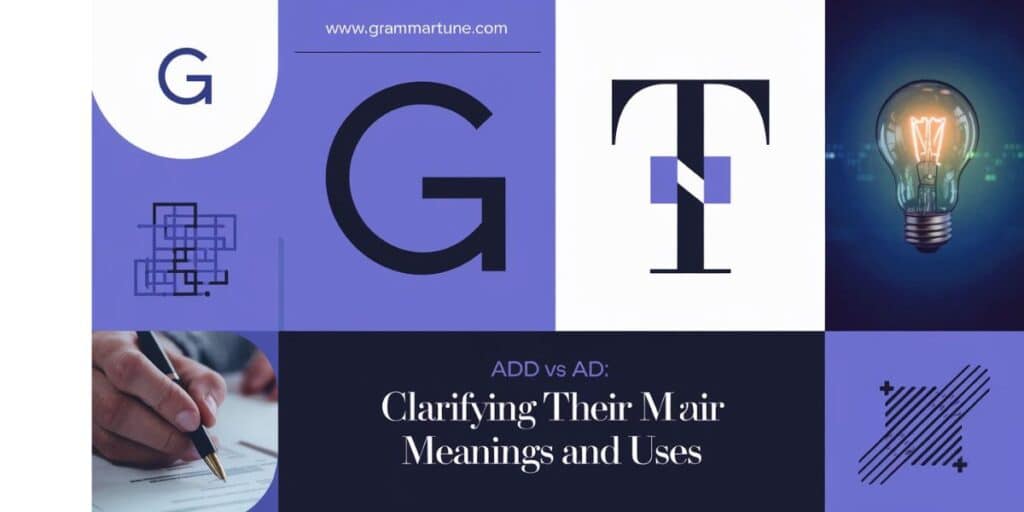dd vs Ad: Clarifying Their Meanings and Uses—these two tiny words often trip people up. Though they sound alike, their meanings couldn’t be more different. One involves mathematics or inclusion, the other relates to advertising.
Confusing the two can make writing look careless. This guide clears up the mix-up and helps you use each one correctly. You’ll also learn where homophones, grammar rules, and spelling errors come into play. By the end, you’ll spot the difference in seconds and write with confidence. Let’s settle the Add vs Ad debate for good.
📘 Understanding the Basics
- 🔍 Why is There Confusion?
- ➕ What Does the Word “Add” Mean?
- 📢 What Does the Word “Ad” Mean?
- 🔁 “Add” vs “Ad”: Differences
- 💡 Meaning
- 🔧 Function
- 🗂 Usage Context
- 📝 Spelling and Pronunciation
- 💡 Meaning
📚 Deep Dive & Practical Usage
- 🧾 Examples in Context
- ✍️ Examples with “Add”
- 📺 Examples with “Ad”
- ✍️ Examples with “Add”
- 🧠 Synonyms and Similar Terms
- ➕ Synonyms for “Add”
- 📣 Synonyms for “Ad”
- ➕ Synonyms for “Add”
- 🏛 Origins of “Add” and “Ad”
- 🔎 Origin of “Add”
- 📜 Origin of “Ad”
- 🔎 Origin of “Add”
- ⚡ Quick Summary
- ❓ Top 5 FAQs
- ✅ Conclusion: Add vs Ad: Clarifying Their Meanings and Uses
Why is There Confusion?
The words “add” and “ad” sound exactly the same. That alone leads to mix-ups, especially in casual speech or quick writing. It’s a classic case of homophones causing headaches.
Both are short, only three letters long, and appear in everyday conversation. Without context, it’s tough to tell which is meant. That’s why this confusion sticks around.
Must read: Forward vs Forwards: Which One Should You Use?
⚡ Quick Summary
Add vs Ad is a classic mix-up caused by identical pronunciation but completely different meanings. “Add” is a verb that means to increase, join, or include. “Ad”, short for advertisement, is a noun used in marketing and media. The key difference? Function and context—you add something, but you watch or create an ad.
Just remember: two d’s for action (add), one d for promotion (ad). Keep this in mind, and you’ll never confuse them again.
What Does the Word “Add” Mean?
Add is to combine, increase. You do it most often in math when you get totals, sums, and the like; but you also do it when you’re including more people or ideas.
Add sugar to coffee, add someone to a group chat. Generally, it means adding something. Think of it as making more.
What Does the Word “Ad” Mean?
“Ad” is a short form for an advertisement-a message to sell or promote something. You see ads on TV, social media, billboards, and even podcasts; they are literally everywhere.
No matter for shoes or software, an ad, in essence, persuades the reader. To attract attention and get the reader to take action-buy, sign up, or find out more.
“Add” vs “Ad”: Differences
Although they sound alike, “add” and “ad” are completely disparate: one is a verb and the other is a noun. That alone sets them apart in how they’re used.
Plus, they relate to totally different ideas—math and inclusion versus marketing and promotion. A quick check of context clears it up fast.
Meaning:
“Add” means to join, increase, or include something. It’s active—it does something. You use it when combining items or ideas.
On the other hand, “ad” refers to a promotional message. It exists to sell, inform, or build a brand. It’s about communication, not action.
You will like: What’s the Past Tense of Cost: Is It Cost or Costed?
Function:
The word “add” is a verb, which means it shows action—something is happening. You add numbers, ingredients, or features.
“Ad” is a noun. It’s a thing, an object. You can create, watch, or skip an ad.
Usage Context:
You’d use “add” in situations involving math, shopping, writing, or tech—like adding files or items to a cart. It fits any setting where more is being included.
“Ad” belongs in media, business, or sales. If someone’s trying to grab attention or promote something, an ad is in play.
Spelling and Pronunciation:
It’s all about the accent, my friend. They sound the same, with the same exact pronunciation: /bed/.
But look closely. “Add” has two d’s, while “ad” has just one. That extra “d” makes a big difference in meaning.
Examples in Context
Sometimes it helps to see how they work in real life. Let’s look at both “add” and “ad” in simple, everyday sentences.
These examples make the usage feel natural and clear, so you won’t second-guess which one fits.
Examples with “Add”
- Please add your name to the list.
- I’ll add more milk if it’s too strong.
- Can we add another topic to the agenda?
Examples with “Ad”
- That funny ad made me buy the shoes.
- I saw an ad for pizza delivery last night.
- They launched a new ad campaign this week.
Synonyms and Similar Terms to “Add” and “Ad”
It helps to know what words can swap in and still make sense. Here are a few alternatives you might come across.
While “add” and “ad” don’t overlap in meaning, each has plenty of synonyms in their own categories.
Synonyms for “Add”
- Combine
- Include
- Attach
Each of these suggests increasing or joining, just like “add” does.
Synonyms for “Ad”
- Commercial
- Promotion
- Spot
All of these relate to advertising, and they’re used in media or marketing contexts.
Origins of “Add” and “Ad”
Looking at where these words come from helps explain their meanings. Both have Latin roots, but they took different paths into English. Knowing their origins gives more insight into why they mean what they do today.
Origin of “Add”
The word “add” comes from Latin addere, meaning “to put near” or “to join.” Over time, it kept that sense of combining or increasing.
It passed through Old French before landing in English, and its core meaning never really changed.
Origin of “Ad”
“Ad” is the short form of advertisement, which is derived from the Latin word advertere, meaning “to turn toward.” It was originally meant to attract one’s attention.
“Ad” itself had made its way into everyday vocabulary by the second decade of the twentieth century, for use in print and in speech alike.
You will like: What’s the Plural of Iris? Explaination with Examples
FAQ’S
Are “add” and “ad” pronounced the same?
Yes, both are pronounced /æd/ like the word “bad” without the “b.” That’s why they’re often confused in speech.
Is “ad” always short for advertisement?
Mostly, yes. “Ad” is the common abbreviation for advertisement, especially in marketing, media, or business contexts.
Can “add” ever be used as a noun?
No, “add” is strictly a verb. If you’re looking for a noun, you might mean addition or added item, depending on the context.
How can I remember the difference between “add” and “ad”?
Here’s a trick: “Add” has two d’s because you’re adding more. “Ad” has just one—like a short message trying to grab your attention.
Why does this mix-up happen so often?
Because they’re homophones—words that sound the same but have different meanings and spellings. That makes it easy to confuse them, especially in writing.
Conclusion
Understanding the difference between Add vs Ad: Clarifying Their Meanings and Uses helps you write more clearly and confidently.The word “add” signifies action in the sense of increase, join, or include.
The term “ad” means advertisement, a noun used in marketing and promotions. While they sound alike, they are completely different in usage and meaning. Knowing the difference, you will never go wrong again! Keeping context in mind will help you stay articulate with your writing and free of mistakes.

Joulia, a seasoned wordsmith and grammar enthusiast, brings over a decade of blogging expertise to Grammar Tune. With a keen eye for linguistic precision and a passion for making complex grammar concepts accessible, he has helped thousands of readers enhance their writing skills. His engaging teaching style and practical approach to language learning have made him a trusted voice in the online grammar community.







